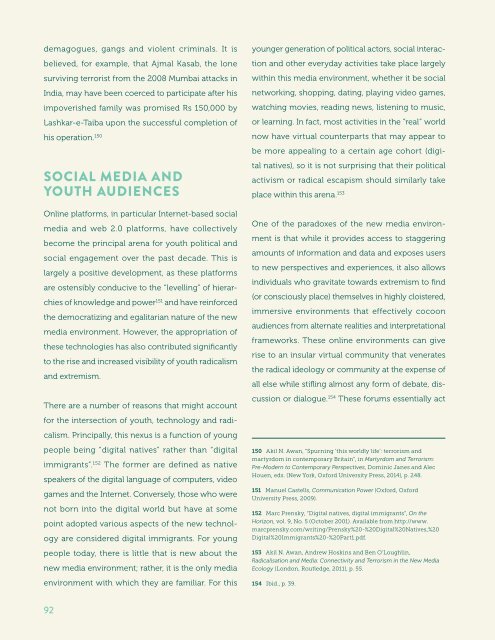YOUTH CIVIC
JieguI2U
JieguI2U
You also want an ePaper? Increase the reach of your titles
YUMPU automatically turns print PDFs into web optimized ePapers that Google loves.
demagogues, gangs and violent criminals. It is<br />
believed, for example, that Ajmal Kasab, the lone<br />
surviving terrorist from the 2008 Mumbai attacks in<br />
India, may have been coerced to participate after his<br />
impoverished family was promised Rs 150,000 by<br />
Lashkar-e-Taiba upon the successful completion of<br />
his operation. 150<br />
SOCIAL MEDIA AND<br />
<strong>YOUTH</strong> AUDIENCES<br />
Online platforms, in particular Internet-based social<br />
media and web 2.0 platforms, have collectively<br />
become the principal arena for youth political and<br />
social engagement over the past decade. This is<br />
largely a positive development, as these platforms<br />
are ostensibly conducive to the “levelling” of hierarchies<br />
of knowledge and power 151 and have reinforced<br />
the democratizing and egalitarian nature of the new<br />
media environment. However, the appropriation of<br />
these technologies has also contributed significantly<br />
to the rise and increased visibility of youth radicalism<br />
and extremism.<br />
There are a number of reasons that might account<br />
for the intersection of youth, technology and radicalism.<br />
Principally, this nexus is a function of young<br />
people being “digital natives” rather than “digital<br />
immigrants”. 152 The former are defined as native<br />
speakers of the digital language of computers, video<br />
games and the Internet. Conversely, those who were<br />
not born into the digital world but have at some<br />
point adopted various aspects of the new technology<br />
are considered digital immigrants. For young<br />
people today, there is little that is new about the<br />
new media environment; rather, it is the only media<br />
environment with which they are familiar. For this<br />
younger generation of political actors, social interaction<br />
and other everyday activities take place largely<br />
within this media environment, whether it be social<br />
networking, shopping, dating, playing video games,<br />
watching movies, reading news, listening to music,<br />
or learning. In fact, most activities in the “real” world<br />
now have virtual counterparts that may appear to<br />
be more appealing to a certain age cohort (digital<br />
natives), so it is not surprising that their political<br />
activism or radical escapism should similarly take<br />
place within this arena. 153<br />
One of the paradoxes of the new media environment<br />
is that while it provides access to staggering<br />
amounts of information and data and exposes users<br />
to new perspectives and experiences, it also allows<br />
individuals who gravitate towards extremism to find<br />
(or consciously place) themselves in highly cloistered,<br />
immersive environments that effectively cocoon<br />
audiences from alternate realities and interpretational<br />
frameworks. These online environments can give<br />
rise to an insular virtual community that venerates<br />
the radical ideology or community at the expense of<br />
all else while stifling almost any form of debate, discussion<br />
or dialogue. 154 These forums essentially act<br />
150 Akil N. Awan, “Spurning ‘this worldly life’: terrorism and<br />
martyrdom in contemporary Britain”, in Martyrdom and Terrorism:<br />
Pre-Modern to Contemporary Perspectives, Dominic Janes and Alec<br />
Houen, eds. (New York, Oxford University Press, 2014), p. 248.<br />
151 Manuel Castells, Communication Power (Oxford, Oxford<br />
University Press, 2009).<br />
152 Marc Prensky, “Digital natives, digital immigrants”, On the<br />
Horizon, vol. 9, No. 5 (October 2001). Available from http://www.<br />
marcprensky.com/writing/Prensky%20-%20Digital%20Natives,%20<br />
Digital%20Immigrants%20-%20Part1.pdf.<br />
153 Akil N. Awan, Andrew Hoskins and Ben O’Loughlin,<br />
Radicalisation and Media: Connectivity and Terrorism in the New Media<br />
Ecology (London, Routledge, 2011), p. 55.<br />
154 Ibid., p. 39.<br />
92


